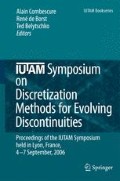Summary
This paper discusses the crack tip asymptotic fields of frictionless and frictional cohesive cracks in quasi-brittle materials. This has been made possible after reformatting the cohesive-law into a special but universal polynomial. For accurate simulation of crack growth in quasi-brittle materials using the extended/generalized finite element method (XFEM), the leading term of the true displacement asymptotic field is used as the enrichment function at the tip of a cohesive crack. The opening component of the same field is also used as the initial guess opening profile of a newly extended cohesive segment. A statically admissible stress recovery (SAR) technique is used to recover the stresses at the crack tip. Finally, a pure mode I cohesive crack problem is analysed to demonstrate the characteristics of global responses and local fields obtained numerically by the XFEM.
Access this chapter
Tax calculation will be finalised at checkout
Purchases are for personal use only
Preview
Unable to display preview. Download preview PDF.
References
Hillerborg A, Modeer E, Petersson PE (1976) Cement Concrete Res 6:773–781
Elices M, Guinea GV, Gómez J, Planas J (2002) Engrg Fract Mech 69:137–163
Karihaloo BL (1995) Fracture mechanics and structural concrete. Addison Wesley Longman, UK
de Borst R, Gutierrez MA, Wells GN, Remmers JJC, Askes H (2004) Int J Numer Meth Engrg 60:289–315
Moës N, Dolbow J, Belytschko T (1999) Int J Numer Meth Engrg 46:131–150
Strouboulis T, Copps K, Babuska I (2001) Comput Meth Appl Mech Engrg 190:4081–4193
Karihaloo BL, Xiao QZ (2003) Comput Struct 81:119–129
Xiao QZ, Karihaloo BL (2005) Recent developments of the extended/generalized FEM and a comparison with the FEM. In: Wu XP (ed) Developments and applications of solid mechanics (Proceedings of the Symposium on Prof M. G. Huang's 90th Birthday). Press of University of Science and Technology of China, Hefei, China, pp. 303–324
Wells GN, Sluys LJ (2001) Int J Numer Meth Engrg 50: 2667–2682
Moës N, Belytschko T (2002) Engrg Fract Mech 69: 813–833
Hansbo A, Hansbo P (2004) Comput Meth Appl Mech Engrg 193: 3523–3540
Zi G, Belytschko T (2003) Int J Numer Meth Engrg 57: 2221–2240
Alfaiate J, Simone A, Sluys LJ (2003) Int J Solids Struct 40: 5799–5817
Mariani S, Perego U (2003) Int J Numer Meth Engrg 58: 103–126
Xiao QZ, Karihaloo BL (2006) J Mech Mater Struct 1: 881–910
Rubinstein AA (2003) Int J Fract 119: L15–L20
Xiao QZ, Karihaloo BL (2004) Statically admissible stress recovery using the moving least squares technique. In: Topping BHV, Mota Soares CA (eds) Progress in computa- tional structures technology. Saxe-Coburg Publications, Stirling, Scotland, pp. 111–138
Xiao QZ, Karihaloo BL (2006) Int J Numer Meth Engrg 66: 1378–1410
Xiao QZ, Karihaloo BL, Liu XY (2007) Incremental-secant modulus iteration scheme and stress recovery for simulating cracking process in quasi-brittle materials using XFEM. Int J Numer Meth Engng 69: 2606–2635.
Cornelissen HAW, Hordijk DA, Reinhardt HW (1986) Heron 31: 45–56.
Wecharatana M (1990) Brittleness index of cementitious composite. In: Supren-ant BA (ed) Serviceability and durability of construction materials, ASCE Publications, New York.
Muskhelishvili NI (1953) Some basic problems of mathematical theory of elasticity. Noordhoff, Holland.
Sih GC, Liebowitz H (1968) Mathematical theories of brittle fracture. In: Liebowitz H (ed) Fracture: An advanced treatise, Vol. II. Academic Press, New York, pp. 67–190
Karihaloo BL, Xiao QZ (2003) Linear and Nonlinear Fracture Mechanics. In: Milne I, Ritchie RO, Karihaloo BL (eds) Comprehensive structural integrity, Vol 2: Karihaloo BL, Knauss WG (eds) Fundamental theories and mechanisms of failure, Chapter 2.03. Elsevier Pergamon, UK, pp. 81–212
Abdalla HM, Karihaloo BL (2004) Mag Concrete Res 56: 597–604
Planas J, Elices M, Guinea GV, Gómez FJ, Cendón DA, Arbilla I (2003) Engrg Fract Mech 70: 1759–1776
Béchet E, Minnebo H, Moës N, Burgardt B (2005) Int J Numer Meth Engrg 64: 1033–1056
Duff IS, Reid JK (1983) ACM Trans Math Softw 9: 302–325
Author information
Authors and Affiliations
Corresponding author
Editor information
Editors and Affiliations
Rights and permissions
Copyright information
© 2007 Springer
About this paper
Cite this paper
Karihaloo, B.L., Xiao, Q.Z. (2007). Accurate Simulation of Frictionless and Frictional Cohesive Crack Growth in Quasi-Brittle Materials Using XFEM. In: Combescure, A., De Borst, R., Belytschko, T. (eds) IUTAM Symposium on Discretization Methods for Evolving Discontinuities. IUTAM Bookseries, vol 5. Springer, Dordrecht. https://doi.org/10.1007/978-1-4020-6530-9_14
Download citation
DOI: https://doi.org/10.1007/978-1-4020-6530-9_14
Publisher Name: Springer, Dordrecht
Print ISBN: 978-1-4020-6529-3
Online ISBN: 978-1-4020-6530-9
eBook Packages: EngineeringEngineering (R0)

